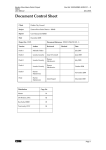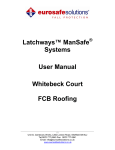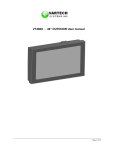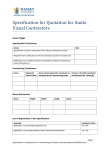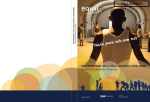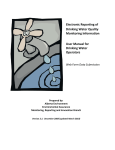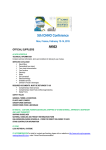Download Letter on Intent: Sub-Committee 3 Specific operating instructions for
Transcript
Version 2.0
Issued: 20/07/2009
DOCUMENT XI:
SPECIFIC OPERATING INSTRUCTIONS FOR SECURE
COMMUNICATIONS
CLASSIFICATION LEVEL
RECORD OF CHANGES
Date
20/07/2009
Issue
2.0
Changes
Updated version with new shape and title
15/11/2006
1.0
Approved draft
DOCUMENT XI: Specific Operating Instructions for Secure Communications
1
Version 2.0
Issued: 20/07/2009
FRAMEWORK AGREEMENT
(S.O.I.S.C.)
SPECIFIC OPERATING INSTRUCTIONS for SECURE
COMMUNICATIONS
PROJECT [NAME]
SECURE COMMUNICATIONS BETWEEN
[COMPANY NAME & LOCATION]
AND
[COMPANY NAME & LOCATION]
AND
[NATIONAL DEFENCE ESTABLISHMENT]
SECURE <DEVICE> <DATA> COMMUNICATIONS
DURING [PROJECT STAGE] STAGE OF
PROJECT [NAME]
[NAME OF COMMUNICATION SYSTEM]
ISSUED BY:
Issue:
Dated:
[ Insert name of NSA/DSA]
[]
[]
DOCUMENT XI: Specific Operating Instructions for Secure Communications
2
Version 2.0
Issued: 20/07/2009
RECORD OF CHANGES
VERSION
AUTHOR
DATE
REASON FOR
CHANGE
DOCUMENT XI: Specific Operating Instructions for Secure Communications
SUPERSEDED
DOCUMENT
3
Version 2.0
Issued: 20/07/2009
TABLE OF CONTENTS
SECTION I - INTRODUCTION .........................................................................................................5
A. PURPOSE ..........................................................................................................................................................5
B. SCOPE................................................................................................................................................................5
C. AUTHORITY RESPONSIBILITY AND APPLICABILITY............................................................................5
SECTION II - GUIDELINES AND REQUIREMENTS.....................................................................7
A. DESCRIPTION OF INFORMATION TRANSFERS........................................................................................7
B. SYSTEM RESTRICTIONS ...............................................................................................................................8
C. CONFIGURATION CONTROL........................................................................................................................8
D. SECURITY AUDITS.........................................................................................................................................8
E. MAINTENANCE ...............................................................................................................................................8
F. DESIGNATED RELEASING AUTHORITY (DRA) ........................................................................................8
G. SYSTEM OPERATORS....................................................................................................................................9
H. CONTROL OF THE <DEVICE MODEL> .....................................................................................................10
SECTION III - PROCEDURES.........................................................................................................11
A. SECURE VOICE .............................................................................................................................................11
B. SECURE DATA FILE TRANSFER ................................................................................................................11
C. SECURE FACSIMILE.....................................................................................................................................13
D. MISCELLANEOUS.........................................................................................................................................14
ATTACHMENT 1 - SECURE VOICE RECORD ............................................................................15
ATTACHMENT 2 - SECURE DATA FILE TRANSFER REQUEST.............................................16
ATTACHMENT 3 - SECURE DATA FILE TRANSFER RECEIPT...............................................17
ATTACHMENT 4 – SECURE FACSIMILE COVER SHEET ...................................................................18
DOCUMENT XI: Specific Operating Instructions for Secure Communications
4
Version 2.0
Issued: 20/07/2009
SECTION I - INTRODUCTION
A. PURPOSE
The purpose of this SPECIFIC OPERATING INSTRUCTIONS for SECURE
COMMUNICATIONS (SOISC) is to provide instructions for the exchange of classified
information between the participating facilities of the under mentioned [companies] and/or national
[defence establishments] for use on the [project name] project during the [project stage] stage in
accordance with relevant mutually agreed security rules of:
a. [company, full postal address]
b. [national defence establishment, full postal address]
B. SCOPE
1. This SOISC complements respective national security policies pertinent to the
control, protection, and transmission of classified information. Additionally, this
SOISC identifies the security procedures for the transfer of classified information
directly between the participating facilities listed in Paragraph A.
2. Classified information shall be exchanged by [secure voice] [secure data file
transfer] [secure facsimile] from authorised terminals. The information will be
limited to the following national classification levels: [delete as appropriate]
[CONFIDENTIAL] and [SECRET].
3. This SOISC will only be in effect during the period when the participants are in the
[project stage] stage, unless otherwise extended by agreement between contractors
and their respective governments. This period is known as the Concession Period.
{Dates might be used instead of “project stage”, but dates may slip.}
C. AUTHORITY RESPONSIBILITY AND APPLICABILITY
1. This SOISC has been approved by the following
Authorities/Designated Security Authorities (NSA's/DSA's):
FR
GE
IT
SP
National
Security
Délégation générale pour l’Armement Département central de la sécurité de
défense et de 1’information (DGA/SDI).
Bundesministerium fur Wirtschaft und Arbeit, Referat VIB 3, Villemombler
Strasse 76, D-53107 Bonn.
Presidenza del Consiglio dei Ministri - Autorità Nazionale per la
Sicurezza/CESIS - III Reparto U.C.Si. - Via di Santa Susanna n.15 00187 Roma.
Secretario de Estado Director del Centro Nacional de Intelligencia.
DOCUMENT XI: Specific Operating Instructions for Secure Communications
5
Version 2.0
Issued: 20/07/2009
SW
UK
Defence Materiel Administration - FMV, Security, SE-115 88 Stockholm
Sweden.
Directorate of Defence Security, Ministry of Defence (MOD) InfoSy(Tech)COMSEC
2. Requests for clarification, proposed changes or revisions to this SOISC should be
directed within the countries to the respective NSA/DSA as listed above, through
established government channels. Amendments will not be made without the
approval of the NSA's/DSA's concerned in consultations with the appropriate
government authorities as appropriate.
3. The NSA's/DSAs have overall responsibility to ensure national compliance with the
security requirements of this <programme/project>.
4. The Cognisant Security Agency (CSA), where applicable and/or stated by relevant
national rules, is responsible for administering and implementing the security aspects
of this SOISC for their respective NSA/DSA’s
{A CSA may be any competent agency or person with security responsibility for the
project/programme. There is no requirement for a CSA to be a Government agency,
although the nation leading on the project may wish to nominate its Ministry of
Defence project management team as its CSA.}
a)
b)
c)
d)
e)
f)
The CSA for France is to be defined on a case by case basis;
The CSA for Germany is : : :;
The CSA for Italy is.;
The CSA for Spain is : : : :
The CSA for Sweden is : : : :
The CSA for the UK is <for a UK project - the project management team>
<for the project of another nation - the Security Controller of the company
concerned>.
5. The Project Security <Officer/Adviser> is [insert name, full postal address,
telephone and facsimile numbers, email address].
6. <The Cryptographic Operating Authority (COA) and point of contact is [insert
details as appropriate]>.
DOCUMENT XI: Specific Operating Instructions for Secure Communications
6
Version 2.0
Issued: 20/07/2009
SECTION II - GUIDELINES AND REQUIREMENTS
A. DESCRIPTION OF INFORMATION TRANSFERS
1. Secure telephone communications will allow the transfer of information classified up
to [insert appropriate security classification] in secure [voice] [data] [facsimile]
modes directly between the participating facilities listed in Section I, Paragraph A.
2. Voice Communications. Secure voice communications shall use <device model>
secure telephones. There will be a <device model> at each participating facility to
allow for secure conversations up to [insert appropriate security classification] level.
3. Data Communications. [insert project name] users will process classified information
on a "stand-alone" terminal within their facility Each participating facility may use a
local area network of computers to process classified information, but shall have a
"stand-alone" terminal for secure data transfers. Data shall be transferred between
the local area network and the stand-alone PC on a removable transfer medium.
When there is a requirement to send data to other participants, data will be
transmitted from the stand-alone PC through an attached <device model> terminal.
In all cases, when data is sent from the PC, the transaction shall be recorded.
4. Facsimile Communications. Secure facsimile communications shall use <device
model> secure telephones. All facsimile transfers shall be recorded.
5. Software and Equipment Requirements.
a) In the context of this SOISC, <device models> and combinations of standalone PC <or> [facsimile machine] with <device model> will be known as
“system equipment”.
b) The [stand-alone PCs] and [facsimile machines] will be provided by the
host facilities.
c) The <responsible> COA will provide <device model> equipment to each
facility detailed in Section I Part A. <device models> will be installed by
local technicians in accordance with [delete as appropriate] [the instructions
in the <device model> Local Manager Guide, which will be issued by the
<responsible> COA] [national physical, personnel and electronic security
regulations for cryptographic equipment protecting <appropriate security
classification> information]. The <responsible> COA will also issue a copy
of the <device model> User Handbook and Security Operating Procedures
to each participating facility.
DOCUMENT XI: Specific Operating Instructions for Secure Communications
7
Version 2.0
Issued: 20/07/2009
B. SYSTEM RESTRICTIONS
1. System equipment shall not be connected to any local area network.
2. System equipment shall be operated only in areas that have been accredited for work
at the relevant security classification.
3. Only information required in the support of the [project name] will be transferred via
the secure telephone communications.
4. When importing data into a receiving secure IT system, the removable transfer
medium shall not be classified higher than the system.
C. CONFIGURATION CONTROL
1. The CSAs are responsible for configuration management of the communications
link.
2. Any proposed changes to the system configuration or to the operating procedures
within this SOISC must be submitted by the participating facilities to the CSAs for
approval, prior to implementation.
D. SECURITY AUDITS
1. The CSAs will review their respective facilities on a regular basis according to
national rules and at least annually to ensure conformance with these instructions and
authorised local security regulations.
E. MAINTENANCE
1. Should a <device model> at a site outside the <responsible nation> require
maintenance, it shall be returned to the <responsible nation> NDA through the
nation's NDA.
F. DESIGNATED RELEASING AUTHORITY (DRA)
1. A Designated Releasing Authority (DRA) and Alternate DRA for each participating
facility will be appointed by the [contractor] <or> [defence establishment]: these
appointments are subject to the approval of the CSA. These individuals will be
DOCUMENT XI: Specific Operating Instructions for Secure Communications
8
Version 2.0
Issued: 20/07/2009
citizens of their respective countries, who are cleared to at least SECRET level by
their government, and are responsible to their governments for the following:
a. Reviewing and approving all material and data prior to its actual transmission
via the secure telephone communications.
b. Acknowledging receipt of all material and data transmitted via the secure
telephone communications.
c. Briefing the system operators to their responsibilities.
d. Ensuring all records required to be executed by the system operators are
maintained in a complete and accurate manner.
e. Producing upon request, by the CSA, any records required to be maintained for
the secure telephone communications.
f. Reporting to their CSA any security violations, unauthorised disclosures or
possible compromises of information transmitted via the secure telephone
communications.
2. In the event the DRA is unable to perform his/her duties, the Alternate DRA will
assume the responsibilities identified above.
G. SYSTEM OPERATORS
1. At each participating site, [project name] personnel, who are nationals of
participating nations, cleared to at least [appropriate security classification] level,
will be assigned duties as system operators. System operators are responsible for the
following:
a. Ensuring that only authorised personnel use the secure telephone
communications for voice.
b. Ensuring that only data authorised by the DRA is transmitted via the secure
telephone communications.
c. Providing to the DRA within a timely manner all material received via the
secure telephone communications for his/her review.
d. Reporting to the DRA all system irregularities, security violations,
unauthorised disclosures or possible compromises as the result of any
transmission.
DOCUMENT XI: Specific Operating Instructions for Secure Communications
9
Version 2.0
Issued: 20/07/2009
e. Executing all records as required relating to the utilisation of the secure
telephone communications.
f. Controlling system equipment as required within this SOISC and as directed
by the controlling COMSEC Custodian.
2. System operators are also responsible to the host Facility Security Control Officer
for compliance with all respective national and facility security regulations pertinent
to the safeguarding, protection, control, and storage of classified material generated
and received via the secure telephone communications.
H. CONTROL OF THE <DEVICE MODEL>
2. [delete if not appropriate] [Each participating site requires the appointment of a
<device model> Local Manager.] The <device model> are registered cryptographic
items in the <responsible nation> and are controlled cryptographic items in the other
nations. They will be issued to the designated system operators at each contractor
facility by the controlling COMSEC Custodian within the COMSEC Material
Control System. All personnel responsible for the control, accountability, and
operation of the terminals will be briefed by the respective COMSEC Custodian as to
his/her responsibilities.
3. <device model> use <specific key material> which is replaced <time plan> under the
arrangements of the <responsible nation> COA. <device model> cryptographic keys
will be marked <appropriate security classification> but approved for use at
<appropriate security classification>, supplied by <responsible nation agency> and
distributed by the <responsible nation> National Distribution Agency (NDA) to the
relevant National Distribution Agencies for distribution within nations. Encryption
keys will be maintained in:
a) [nation A] by: [participating site], COMSEC Account Number [number];
[participating site], COMSEC Account Number [number].
b) [nation B] by: [participating site], COMSEC Account Number [number];
[participating site], COMSEC Account Number [number].
DOCUMENT XI: Specific Operating Instructions for Secure Communications
10
Version 2.0
Issued: 20/07/2009
SECTION III - PROCEDURES
A. SECURE VOICE
1. The following procedures shall be implemented when utilising a <device model> for
a classified voice communication:
a. The terminal must be located in an area conducive to acoustic security. The area
should be constructed in a manner that would preclude non-cleared personnel
gaining access to the information being discussed.
b. Secure calls should be prearranged to ensure system operators are available at
both ends.
c. The system operator initiating the call, and the system operator receiving the
call, will execute the "Secure Voice Record" (see Attachment 1). This shall
include call duration (date/starting and ending times), names, citizenship and
clearance level of all participants and the unclassified subject matter of
discussion.
d. It is the responsibility of each system operator to verify the identities and
clearance levels of the participants at their respective sites.
e. Every participant in a conversation has the responsibility of ensuring that the
appropriate foreign disclosure authorisations for the information being discussed
have been received from their respective governments.
f. Although prior approval to conduct a classified conversation is not required from
the DRA, any classified notes made during a call should be passed to the DRA.
It is the responsibility of the participant originating such material to classify (or
otherwise mark), protect and control it in accordance with the host facility's
security regulations and procedures.
g. The DRA will review the Secure Voice Record on a weekly basis to ensure the
records are being properly maintained.
{By mutual agreement of the NSA's/DSAs, the Secure Voice Record may be not
included.}
B. SECURE DATA FILE TRANSFER
1. All data to be transmitted over the secure telephone communications must be
approved by the DRA prior to transmission. Interactive processing between the
system equipment PC workstations is not permitted.
DOCUMENT XI: Specific Operating Instructions for Secure Communications
11
Version 2.0
Issued: 20/07/2009
2. The requesting sender of the data file is responsible for:
a. Ensuring that the removable transfer medium, to which the relevant data file will
be copied, is pre-formatted to ensure erasure of all other information that may
have previously resided on that medium. Only files for transmission may reside
on the medium.
b. Ensuring that the appropriate classification level indicators are contained within
the file and on the outside of the medium.
c. Initiating a "Secure Data File Transfer Request" form (Attachment 2), including
the number of files to transfer and their names, classifications and descriptions.
3. The requesting sender will then obtain the approval of the facility DRA. After DRA
approval has been received, the transfer medium, along with the request, will be
provided to the system operator for transmission.
4. Upon receipt of the Secure Data File Transfer Request and the transfer medium, the
sending system operator will:
a. Ensure the Secure Data File Transfer Request is complete so far.
b. Initiate a secure session with the distant system operator, pass the details from
the Secure Data File Transfer request, including the number of files to transfer
and their names, classifications and descriptions, and transmit the file(s).
5. After transmission, the sending system operator shall:
a. Confirm with the Receiving Facility System Operator that all data files listed on
the Secure Data File Transfer Request were received.
b. Complete the remainder of the Secure Data File Transfer Request.
c. Retain the Secure Data File Transfer Request.
d. Release the transfer medium back to the requesting sender in accordance with
the host facility's security regulations and procedures.
6. Upon initiation of a secure data file transfer session, the receiving system operator
shall begin completion of a Secure Data File Transfer Receipt (Attachment 3), in
accordance with the details passed by the sending system operator.
7. Upon completion of the transfer session, the receiving system operator shall
a. Complete the Secure Data File Transfer Receipt.
DOCUMENT XI: Specific Operating Instructions for Secure Communications
12
Version 2.0
Issued: 20/07/2009
b. Ensure that the transfer medium is marked with the highest classification level
shown on the Secure Data File Transfer Receipt.
c. Provide the transfer medium to the DRA for his/her acceptance.
d. Retain the Secure Data File Transfer Receipt and distribute the transfer medium
to the Intended Addressee in accordance with the host facility's security
regulations and procedures.
8. As an alternative to passing the information about the transfer verbally to the
receiving system operator, the sending system operator may create a computer text
file, in which to list the relevant information from the Secure Data File Transfer
Request, and transmit this at the beginning of the data transfer.
C. SECURE FACSIMILE
1. All material required to be transmitted via secure facsimile must be approved by the
DRA prior to transmission.
2. Material for a secure facsimile transmission must be accompanied by a "Secure
Facsimile Cover Sheet" (see Attachment 4).
3. The requesting sender will complete the facsimile cover sheet and obtain the
approval of the facility DRA. After DRA approval has been received, the material,
along with the Secure Facsimile Cover Sheet, will be provided to the system operator
for transmission.
4. Upon receipt of the material and Secure Facsimile Cover Sheet, the sending system
operator will:
a. Ensure that the cover sheet is complete.
b. Assign a sequential transmission number.
c. Annotate on the cover his/her name and initials.
d. Establish a voice connection with the receiving system operator.
e. If the connection is made, annotate the date and time of transmission on the
cover.
f. Initiate a secure facsimile session and transmit the material.
DOCUMENT XI: Specific Operating Instructions for Secure Communications
13
Version 2.0
Issued: 20/07/2009
5. After transmission, the sending system operator will confirm that all material was
received. The sending system operator will retain a copy of the facsimile cover sheet
on file and release the material back to the requesting sender in accordance with the
host facility's security regulations and procedures.
6. Upon receipt of the facsimile transmission, the receiving system operator will:
a. Annotate on the Secure Facsimile Cover Sheet his/her name and initials.
b. Provide the material to the DRA for his/her acceptance.
c. After the DRA's acceptance, retain a copy of the Secure Facsimile Cover Sheet
on file and distribute the material to the addressee in accordance with the host
facility's security regulations and procedures.
D. MISCELLANEOUS
1. In the event a secure transmission is not completed during a session and the session,
for whatever reason, cannot be re-established, the session will be considered to be
complete. Any "partial" receipt of material/data will be provided to the DRA for
approval and processed in accordance with the host facility's security regulations and
procedures.
2. All transmission/receipt records will be maintained during the Concession Period and
disposed of at the conclusion of the Concession Period by each contractor security
staff only in accordance with the instructions of [insert relevant authority].
DOCUMENT XI: Specific Operating Instructions for Secure Communications
14
Version 2.0
Issued: 20/07/2009
ATTACHMENT 1 - SECURE VOICE RECORD
SECURE VOICE RECORD
Facility location _____________________
DATE
TIME
STARTING
TIME
ENDING
NAMES OF PARTICIPANTS
CITIZENSHIP/CLEARANCE
SUBJECT OF DISCUSSION
(Description must be
UNCLASSIFIED)
DOCUMENT XI: Specific Operating Instructions for Secure Communications
15
Version 2.0
Issued: 20/07/2009
ATTACHMENT 2 - SECURE DATA FILE TRANSFER REQUEST
Name/Position/Title of
Requesting Sender
_________________________________________________
Name/Position/Title of
Intended Addressee: ________________________________________________
Number of Files To Transfer: __________________________
FILE NAME(S)
CLASSIFICATION
DESCRIPTION (INCLUDING No. OF
BYTES)
Name & Signature of Approving
Designated Releasing Authority: _____________________________________ Date: _________
(Releasing Facility)
Transmitting Facility: ________________________________________________
Transmission Number: _______
Date of transmission: ____________Start Time: _________________Stop Time: _____________
Status of Transmission: _____________________________ (successful/partial)
Receiving Facility System Operator Name: ____________________________________________
Transmitting Facility System Operator Name: ___________________________ Initials: ________
DOCUMENT XI: Specific Operating Instructions for Secure Communications
16
Version 2.0
Issued: 20/07/2009
ATTACHMENT 3 - SECURE DATA FILE TRANSFER RECEIPT
Name of Approving
Designated Releasing Authority: ______________________________________ Date: __________
(Sending Facility)
Transmitting Facility: ____________________________________________
System Operator Name: ______________________________ Transmission Number: __________
Receiving Facility: _________________________________________________
System Operator Name & Initials: ___________________________________________________
Number of Files Received: _____________________________ Date of transmission: __________
Start Time: __________
Stop Time: __________
Name/Position/Title of
Sender: ______________________________________________________________________
Name/Position/Title of
Intended Addressee: __________________________________________________________
FILE NAME(S)
CLASSIFICATION
DESCRIPTION (INCLUDING No. OF
BYTES)
Name & Signature of Approving
Designated Releasing Authority:
(Receiving Facility)
______________________________________Date ___________
DOCUMENT XI: Specific Operating Instructions for Secure Communications
17
Version 2.0
Issued: 20/07/2009
ATTACHMENT 4 – secure FACSIMILE COVER SHEET
________________________________
(Classification Level of Cover Sheet if required)
COVERING _________________________________
(Classification Level of Transmitted Document)
FACSIMILE COVER SHEET
Name/Position/Title of
Requesting Sender
_________________________________________________________
Name/Position/Title of
Intended Addressee: ________________________________________________________
Subject/Description of Document: _______________________________________________
Comments: __________________________________________________________________
Name and Signature of Approving
Designated Releasing Authority: ___________________________________ Date: _________
(Releasing Facility)
Transmitting Facility: ______________________________ Transmission Number: _________
Number of pages (including this page): _______ Date & Time of Transmission: ____________
System Operator Name & Initials: _________________________________________________
(Transmitting Facility)
System Operator Name & Initials: _________________________________________________
(Receiving Facility)
Status of Transmission: _____________________________ (successful/partial)
Name & Signature of Approving
Designated Releasing Authority: _____________________________________ Date:_________
(Receiving Facility)
COVERING _________________________________
(Classification Level of Transmitted Document)
___________________________________
(Classification Level of Cover sheet if required)
DOCUMENT XI: Specific Operating Instructions for Secure Communications
18
Version 2.0
DOCUMENT XI: Specific Operating Instructions for Secure Communications
Issued: 20/07/2009
19



















